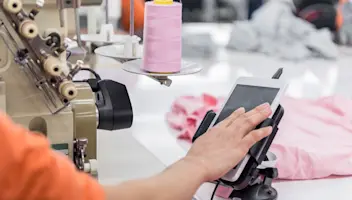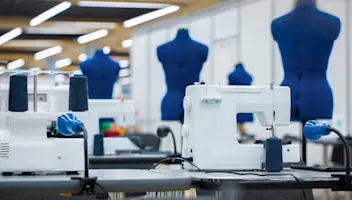4 Apparel Industry Challenges and How to Conquer Them
4 Apparel Industry Challenges and How to Conquer Them
4 Apparel Industry Challenges and How to Conquer Them
14 Jun 2022
Aptean Staff Writer
When most of us go out to buy a new pair of jeans or a jacket, we think about brand, size or color. Very few people are aware of how much goes into the manufacturing of apparel. There are generally five broad steps in the clothing manufacturing process:
Product Development
Production Planning
Cutting Process
Manufacturing and Quality Control
Delivery
Each of these steps has several parts, and things can go wrong at any stage in the manufacturing process especially with the fashion industry facing issues that hamper growth and create inefficiencies within production lines. For instance, supply chain delays, a constant issue for every industry in a post-pandemic world, can delay manufacturing. Lack of collaboration and communication will create problems during the product development phase. Failure to manage workers leads to quality issues during production. Once products are finalized and shipped, inventory management and demand planning concerns can impede products getting delivered to market on time.
The solution to overcome these common apparel industry challenges? The right technology. Apparel manufacturers and distributors need intelligent production management at every stage of the process, from concept to consumer. In the article below, we’ll outline some of the most common issues that businesses like yours face every day and explore the solutions that will help you overcome them.
Communication Issues
In the product development stage, timely communication is crucial. Unfortunately, if your organization is still using disparate email, Excel spreadsheets and design software applications at this phase, communications between your designers and suppliers will always be delayed. For example, let’s say that a designer is trying to get pricing on raw linen for a jacket. If they are still using manual means, it could take endless phone calls and emails. Then, even after they obtain a price, they must still calculate landed costs if the supplier is overseas. With product lifecycle management (PLM) software, not only do designers have a one-stop shop for supplier information, but suppliers and manufacturers can have access to the data they need to collaborate with you.
When you integrate your PLM with an industry-specific ERP, you can effectively communicate with your clients, stakeholders and even accounting at every point along the way as each design comes to fruition. Designers can share Tech Pack information in one central location, so that everyone involved in the project has accurate, up-to-date data. That means that any changes, updates and conversations are all documented and easily accessible.
Worker Accountability
In a typical apparel manufacturing company, there might be hundreds of employees working on different tasks. There are usually cutting, sewing and finishing stations, as well as packaging and quality control (QC) zones. If your manufacturing business is still operating without technology-based processes, the workers are spread across the factory floor and often work in silos. This style of manufacturing discourages interaction, except within specific teams. It also means there is no way to share information or for workers to understand progress against production goals. Overall, this reduces the efficiency of your operation and contributes to low employee morale.
In today’s modern business climate, where stakeholders and consumers demand full transparency and accountability, apparel manufacturers need a solution where they can track both production and defects.
With a solution like shop floor control (SFC) you get real-time access to production data at every level of your organization. Managers can project production data onto big screens overhead, so that workers and teams can see how they’re doing throughout the day. If there are issues with production or a machine breaks down, floor supervisors get notified immediately so that the problem can be addressed.
With SFC software, workers use tablets to scan each item as it’s completed, which eliminates the need for manual reporting. No more gum sheets to record each item completed. No more errors with manual production counts. Instead, management gets verifiable data about production status, which means they can keep their promises. SFC ensures optimally functioning shop floor operations and guarantees that your business meets both production targets and delivery commitments.
Inventory Management
Modern garment manufacturing is constantly evolving because modern consumers demand the latest trends, but also want sustainable manufacturing practices. More than any other industry, apparel is dependent on consumer tastes, which can change daily. While correct inventory management isn’t an issue for just the apparel industry, it does have unique challenges that other manufacturers don’t face.
Energy prices are climbing worldwide, which means that manufacturing costs are rising also. It’s a trickle-down problem that starts with the manufacturer and affects every part of the supply chain. Finding new suppliers or manufacturers isn’t always an option, so using technology to maintain good supply-chain relationships is crucial for inventory control.
With an apparel ERP, you eliminate inventory silos between channels, which ensures that you achieve the perfect product assortment. This helps you avoid stock-outs and lets you allocate items to the correct distribution center for your retailers. You’ll free up cash flow because you won’t be sitting on excess inventory that you cannot sell and with one source of the truth, you’ll have a unified, real-time picture of inventory data across all your warehouses. In addition, when you integrate your ERP with PLM and SFC apparel software, you’ll have current data on where every order is in the process—from design to distribution.
Inclusive Sizing and Diverse Options
The trend toward inclusive sizing and diversity in the fashion industry is a positive one, but it does make the designer’s job more difficult. Today’s consumer wants fashion tailored toward diverse options, such as body positivity and gender fluidity, with a variety of products that suit size, identity and cultural considerations.
Having a small “plus-size” collection won’t cut it anymore. Did you know that 68% of American women wear a size 14 or above? And that number is growing with analysts predicting that the market for larger-sized clothing will grow to some $700 billion globally in the next few years. For modern clothing manufacturers like you, the trick is to embrace that fact and make inclusive clothing. The question is, how can you pivot and make a successful line that addresses the needs of these viable markets? The answer is a PLM.
An agile PLM system addresses size, cost and execution challenges, because it stores all product information on a single collaborative platform. By including libraries of materials, components and styles, a PLM empowers your design and development teams to adapt existing styles to include new sizes or create crossover unisex designs that would suit anyone. And, best of all, your PLM gives you full visibility into costs at every stage of the design process.
Designers and production teams can manage the full sampling process using the immediate visibility of information and collaborative tools at their disposal. Your teams can have real-time conversations about fit, or they can make changes to fabrics or trim if suppliers cannot source the items they want. Everyone has the same information and up-to-date data, so that sizing and fit are consistently accurate across products. This reduces pressure on your design and production teams because it streamlines product development even with the introduction of different size ranges or gender-neutral items.
Technology is changing the way we do everything, and the apparel industry is no exception. Fashion has always been at the forefront of innovation, but consumer expectations have reached an all-time high. Every aspect of the apparel industry can be automated or enhanced by technology, because the right tools lead to faster production, better inventory management and allow brands to make a wider range of options.
Here at Aptean, we strive everyday to help our customers overcome the toughest challenges in their industry. That’s why we have a suite of products designed to tackle your most pressing apparel industry challenges and help your business thrive in this competitive market. From tailored ERP solutions to specialized PLM—we’ve got your requirements all sewn up.
Creativity and technology are a great mix—your apparel manufacturing company can delve into a world of new business opportunities when you combine the two. Do you want to know more about how to leverage technology in fashion? Contact us to discover how, now.
Related Articles





Ready to start transforming your shop floor?
We’ve got the specialized MES solutions you need to conquer your industry challenges.



